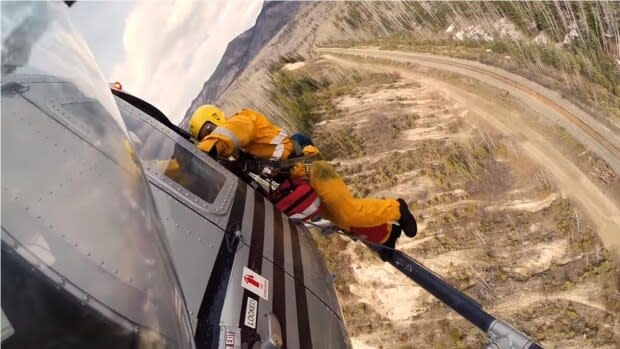OPINION | As wildfire threat grows, UCP cuts to remote rappel team are a risky gamble

The rural communities of Alberta are intimately aware of the growing threat of wildfire.
The 2011 Flat Top Complex Wildfires in Slave Lake and the 2016 Horse River Wildfire in Fort McMurray — the latter the costliest natural disaster in Canadian history, in terms of insured losses — affected the lives of tens of thousands of Albertans.
The 2019 fire season saw a record area burned during the spring, and thousands of people evacuated in the High Level region. Wildfire research unequivocally shows the size and severity of forest fires are increasing and that fire seasons are becoming longer in Canada.
Record-breaking seasons in terms of the number of wildfires, area burned, and firefighting costs are becoming the norm rather than the exception.
Against this backdrop of increasing wildfire risk and management concerns, the UCP government has announced cuts to its wildfire suppression program. The proposed cuts and the rationale presented by the UCP government are short-sighted. Without doubt, these cuts will directly impact the safety and livelihoods of rural communities in Alberta.
Among the immediate casualties is the Alberta Wildland Firefighter Rappel Program, which since 1983 has been the main line of defence for rural communities against wildfires that start in remote areas.
Deployed provincially as nine crews of seven, the men and women in the program are trained to rappel from helicopters and aggressively contain fires while they still are small.
In defending the cancellation of the rappel program, the UCP government stated that the rappel crews were not being "used effectively." For evidence, they cited statistics that the crews rappelled into only two per cent of fires in 2019. What is needed, they claimed, are more "boots on the ground."
What the UCP government does not understand (or admit) is that these rapid deployments in remote areas, though few in number, ultimately reduce the need for more "boots on the ground" by containing wildfires before they spread. And they do so in areas other crews simply cannot access.
Alternatives are dangerous.
Government alternative 'ignores basic facts'
On a wildfire with no potential for helicopter landings, rappel crews are placed directly on the fire perimeter to begin fighting the flames. The alternate scenario is landing, sometimes kilometres away, and dropping a crew which then needs to walk to the fire. As any firefighter will tell you, having unburnt fuel between you and a fire is dangerous, and one of the leading causes of firefighter entrapments and fatalities in North America.
The UCP suggestion that the Human External Cargo (HEC) Program can offer a direct replacement ignores basic facts.

A single rappel crew in a Bell 205 or 212 helicopter has the expertise, personnel and gear required to action up to four fires simultaneously, using both rappel and conventional approaches. This capability far exceeds the HEC program.
In addition, rappel crews build landing pads on new or large complex wildfires, providing access for other crews.
The rappel program offers other services for Alberta, too.
Pine beetles, prescribed burns, search and rescue
They also rappel into remote forests of the province to control mountain pine beetle and execute prescribed burns.
On several occasions, they have even been called upon to rappel into aircraft crash sites as first responders or to help with search and rescue.
For almost four decades, the Alberta Wildfire Rappel crews have answered the call in some of the most demanding situations imaginable. Make no mistake, the team being cut by the UCP is a world-class, professional, wildland firefighting operation.
The government's plan appears to be to replace these professional firefighters with contract crews who they claim do "90 per cent of the work on wildfires already."
To clarify, contract crews are not hired for initial attack. Contract crews, when required, generally work on wildfires that have escaped containment, which in Alberta represents approximately three per cent of all fires. The other 97 per cent are handled by the professionals and, because of that, you never hear about them.
Annoyance for some, threat for others
For many of us who live in urban centres, wildfires are mostly a smoky annoyance. A wildfire may affect your ability to enjoy your summer holidays or, depending on your health, may significantly limit your time outside.
But for those of us who live or work in the rural, forested communities of Alberta, wildfires pose a looming threat.
Increasingly, homes are lost, communities are evacuated, and hundreds of thousands of hectares of merchantable timber are burned. The disruption to lives and industry, including forestry and oil and gas, can be significant.

Against the backdrop of these personal and economic risks, cutting the rappel program — a proven, effective, wildfire suppression program — to save a few dollars is bad public policy.
Instead, the UCP government should better utilize the rappel program and its personnel as an asset representing four decades of wildfire experience and training.
By reinstating the rappel program as a provincial resource, rather than tied to a specific district, the crews would once again be able to effectively suppress fires throughout Alberta.
Additionally, the expertise and unique skill set of these crews should be increasingly harnessed to help with wildfire risk mitigation around communities and remote areas of the province through prescribed burns and fuel load reduction.
The UCP cuts are a waste of a vital part of the Alberta wildfire program and, ultimately, the public might bear much larger costs for such an error.
This column is an opinion. For more information about our commentary section, please read this editor's blog and our FAQ.


